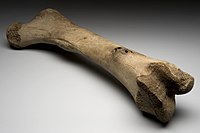
Photo from wikipedia
Prolonged use of antiresorptives such as the bisphosphonate alendronate (ALN) and the RANKL inhibitor denosumab (DMAb) are associated with rare cases of atypical femoral fracture (AFF). The etiology of AFF… Click to show full abstract
Prolonged use of antiresorptives such as the bisphosphonate alendronate (ALN) and the RANKL inhibitor denosumab (DMAb) are associated with rare cases of atypical femoral fracture (AFF). The etiology of AFF is unclear, but it has been hypothesized that potent osteoclast inhibitors may reduce bone fatigue resistance. The purpose of this study was to quantify the relationship between antiresorptive treatment and fatigue life (cycles to failure) in bone from ovariectomized cynomolgus monkeys. We analyzed humeral bone from 30 animals across five treatment groups. Animals were treated for 12 months with subcutaneous (sc) vehicle (VEH), sc DMAb (25 mg/kg/month), or intravenous (iv) ALN (50 μg/kg/month). Another group received 6 months VEH followed by 6 months DMAb (VEH‐DMAb), and the final group received 6 months ALN followed by 6 months DMAb (ALN‐DMAb). A total of 240 cortical beam samples were cyclically tested in four‐point bending at 80, 100, 120, or 140 MPa peak stress. High‐resolution imaging and density measurements were performed to evaluate bone microstructure and composition. Samples from the ALN (p = 0.014), ALN‐DMAb (p = 0.008), and DMAb (p < 0.001) groups illustrated higher fatigue‐life measurements than VEH. For example, at 140 MPa the VEH group demonstrated a median ± interquartile range (IQR) fatigue life of 1987 ± 10593 cycles, while animals in the ALN, ALN‐DMAb, and DMAb groups survived 9850 ± 13648 (+395% versus VEH), 10493 ± 16796 (+428%), and 14495 ± 49299 (+629%) cycles, respectively. All antiresorptive treatment groups demonstrated lower porosity, smaller pore size, greater pore spacing, and lower number of canals versus VEH (p < 0.001). Antiresorptive treatment was also associated with greater apparent density, dry density, and ash density (p ≤ 0.03). We did not detect detrimental changes following antiresorptive treatments that would explain their association with AFF. In contrast, 12 months of treatment may have a protective effect against fatigue fractures. © 2022 American Society for Bone and Mineral Research (ASBMR).
Journal Title: Journal of Bone and Mineral Research
Year Published: 2022
Link to full text (if available)
Share on Social Media: Sign Up to like & get
recommendations!